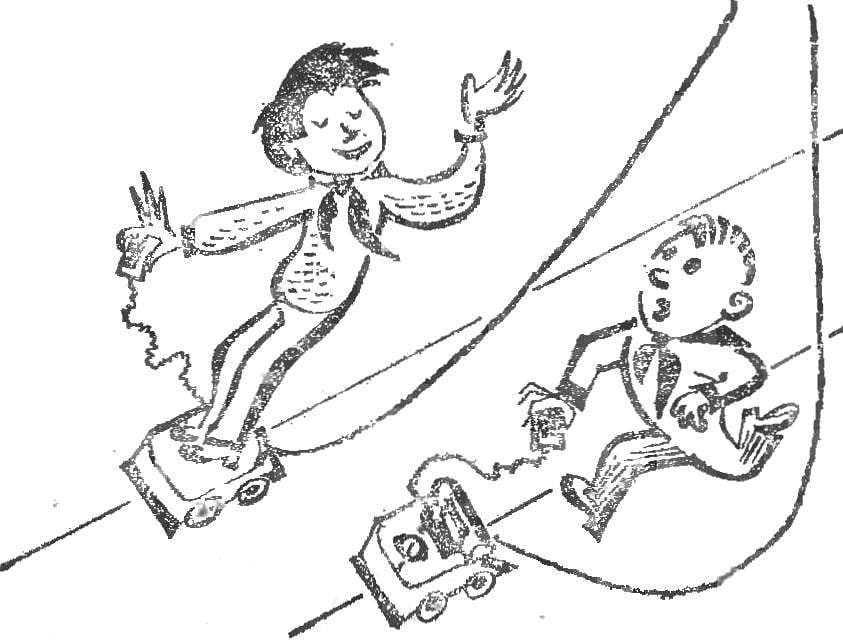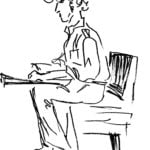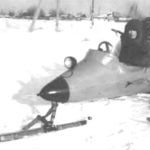 In this competition almost everything was as really big car races: clearly marked and numbered paths, a huge inscription “Start” and “Finish” bright lights, signal lights, gambling, overlapping the voice of the broadcaster the cheers of the fans, overtaking each other swift cars. Still, the racing was unusual. They were not on the racetrack, and in the great hall of one of Omsk schools, and even the largest of launched cars easily fit in the glove box of the usual “Zaporozhets”. As for the racers, most of them have not had time to get out of the pioneer age, and some even from October.
In this competition almost everything was as really big car races: clearly marked and numbered paths, a huge inscription “Start” and “Finish” bright lights, signal lights, gambling, overlapping the voice of the broadcaster the cheers of the fans, overtaking each other swift cars. Still, the racing was unusual. They were not on the racetrack, and in the great hall of one of Omsk schools, and even the largest of launched cars easily fit in the glove box of the usual “Zaporozhets”. As for the racers, most of them have not had time to get out of the pioneer age, and some even from October.
Informing referee calls the participants of the next race. At the start four a young athlete. They are certainly not driving, and near their cars.
The red signal of the traffic light start gives way to yellow. Attention! Flashes green, and the car rushes forward. And behind them, guys on the go (or rather run) driving light models with portable remotes.
Pioneer racing is a new event for the young avtomodelistov. However, their rules and requirements for the models do not fit into the strict confines of sports classification, and speed is relatively small. But the problem is solved here is different: to help the youngest as early as possible to join the technical art, to know the attractive power of sport to overcome the first, most difficult step on the way to sports and design heights. Are born the race we have in Omsk the regional suit.
The organizers tried to hold competitions, maintaining a level of “classical” self-similar events: they were judged by qualified judges appointed by the regional Federation, the winners were awarded with these diplomas, ribbons, Champions and prizes, best young modelers, the regional Committee of the Komsomol was awarded the permits in “Artek”.
Pioneer racing is very promising. Because they can prepare and conduct at any school: do not prevent even the absence of a track or challenging tracks for the construction of the models themselves does not require any complex equipment.
What are the basic rules? The composition of each of the participating teams consists of three model classes: A — model sports car formula “K” (cards with one microelectrophoresis), B — model-copy a traffic or sports car with closed body, In the electric aircar. The micromotor can be used only for domestic and only from among applicants in the retail sale. Change the design of the engine and rewind are not allowed.

Fig. 1. The model class:
1 — frame base, 2 — shaft engine with clutch, 3 — motor, 4 — clamp, 5 — pin plate, 6 — axis, 7 — bearing bracket 8 — driving wheel Ø 40 mm, 9 — led Ø 30 mm, 10 — foot control (only for “karts”), 11 — a guide clip.
The indispensable accessory of each model tocotriene pins connected by conductors with terminals of the motor, and the guide bracket with the holes for passing the steel rail of the thread. Pins it is best to take from the old octal tubes; this will provide them an exact match with the sockets of the plug. System power transmission range of the friction, belt drive, gears with gears of the clock.
Each model is inspected. Manufacturing quality is assessed comprehensively on a scale from one to five points.
A few words about the track. Its length is 15-25 m depends on the size of the facility, which hosts the race. On the floor are laid out four parallel tracks along each of which is stretched a guide cord thread (thickness 0.2—0.3 mm).
The competitions are conducted according to the most objective circular system: each participant can be found in races one time with all the competitors. The compositions of the starting and current racers tracks (the latter change from-in to-in) are determined by the numbers assigned to the models. Convenient to use for this table, used in Motorsport for judging racing on the dirt track and ice. Scoring is the same as in avtomotovelo: the contestant who finished first gets three points; second two points, third one and fourth zero points. Mathematical patterns allow to make such schemes only for a certain number of racers: nine, thirteen or sixteen. With a larger number of starters in any class, divide participants into subgroups and to hold the first semi-finals and then the finals. With less you can combine two of the same class, play a championship, and then “parlasse” to determine positions.
Although the use of diagrams of the races, converted to the starting table statements, not always convenient, we do not suggest to the organisers to abandon them and let the participants start one by one, using duration: the competition rider only the arrow of the stopwatch loses much in entertainment and sports intensity. From the point of view of security it is inappropriate to bring power to the model guide cordovil threads.
Going to start, the Modeler receives from the judges the remote control, which is connected to the car flexible wire with a length of 1.5—2 m. the Other wire, length 8-13 m, each remote control with plug and socket connects to a socket hanging in the middle distance at a height of 2-2. 5 m Outlets connected in parallel, are connected to the rectifier. The magnitude of the rectified voltage should be chosen empirically so that the motor terminal model, it’s made up of 4-8 V.
The program of competitions includes a competition ka best knowledge of traffic rules: rules for pedestrians, passengers and cyclists.
The result of the race is determined by the sum of points scored by the modeller in all races. These points are added the points obtained at inspection, and the result of the theoretical test on the rules of the road. In case of equal points the riders, claiming the prize, the winner is determined by additional stop (points for it not charged). Other participants have the advantage in case of equal points revealed by the highest number first, then second places. Team score is the sum of points received by all team members.
BUILDING MODELS
To build a small racing car can be at home, but it is better to do this in a circle “Skillful hands” in school, in the House of pioneers. Then you will be able to organize a team: because the pioneer racing involved three different model classes.
The model is A little micro-car racing type kart. Many of you have probably seen the competition karting — an exciting race of small fast cars with motorcycle engines. Our “cards” similar to the real, only many times smaller and it works, of course, much easier. The design of the “map” shown in figure 1.
The frame 1 of the model should be cut out from boards with a thickness of 8-10 mm. At her set microelectronical 3. To secure it, cut it out and lignite sheet, a clamp 4, with which the motor is fixed on the frame by two screws. In the rear of the frame saw through the groove to the axis 6. Axis is best done from a Bicycle spoke. The drive wheels 8 saw chetyrehkilometrovoy jigsaw from plywood. In the center of the wheel drill a hole. On the wheel, put the tyre is a ring of thin rubber hose (you can use an old Bicycle camera].
Wheels secure on the axle as shown in the figure, using stuffed they tin washers that are welded to the axle. There is another way: glue them to the shaft by glue BF-2. You can use ready-made wheels from old toys.
Axis b set the frame on two bearing brackets 7, curved tin.
The rotation of the motor on the driving axle of the model is transmitted by friction: to wear on a motor shaft 2 vinyl chloride tube (a piece of insulation from the wire] is pressed against the rubber tire and rotate the wheel. After installing the motor and rear axle with wheels need to adjust the contact force of the motor shaft to the tire, placing the motor strip so that the shaft is slipping, but not against the wheel too hard: it will overload the engine.
9 front wheels attach to the frame with screws. Both sides need wheels you need to install washers. Control pedal 10 are made of sheet metal. The driver’s seat can be cut from wood, steering column and a steering wheel made of steel or copper wire.
Very important details of the models of all three classes — guide loops 11. They install from the bottom in the front and rear parts of the frame model. Stretched on the track racing thin steel wire is passed through holes in the brackets. Thanks to this model’s running right on track and cannot deviate from the treadmill. The dimensions of the guide brackets shown in figure 1; they should be kept accurately.

The model “map” is depicted in the figure below, has some” details. Frame sawed out of plywood with a thickness of 4-5 mm. the Axis of the wheels mounted in bearings made from sheet metal. And the wheels are made of coils for the threads of No. 10; inserted into the hole in the glue section of the pencil, and in it after you remove the clog steel stylus axis.
In this model, the engine rotates the wheels via a belt transmission. On the axle of the drive wheels is installed on glue the pulley. It is made of two pieces of the bobbins. Coils need to take smaller diameter than the wheel model. The device of the pulley can be seen from Fig. The groove is made round with a file after gluing. On the pulley is worn a simple belt — a thin rubber ring.
It is better to use in the model of gear — two gears of the clock, or clockwork toy. This transfer provides the least power loss. Remember that the number of driven gear teeth must be 3-5 times more than a lead mounted on the motor shaft.
Model class B (Fig. 2) — a copy of any car, truck, sports car or bus. The main nodes of its chassis are the same as the “map”. And the body can be cut from cardboard, paper, or cut from plywood, glue and paint. Can be applied to the wall body and papier-mache. To do this, from plasticine or clay, make a blank form of any of the body.
For vyklicky use newsprint cut into strips with a width of 15-20 mm, and flour paste. The first layer — separation — imposed well-soaked paper without glue. After drying glued 5-6 layers as shown in figure 3, ka. And stickers after every two layers, the necessary drying. Shaped body putty, is treated with a skin color.
Model class (Fig. 4) is an aircar with a propeller and one electric motor. The case is made of pine or spruce rails with a cross-section 12X12 mm In the front and rear parts of the se are pairwise at a distance of 10 mm apart drilled holes Ø 1 mm, through which are passed pieces of wire, allied, forming a suspension model. Their ends together with the axes of the wheels wrapped with copper wire and OPANA soft solder.
Ball bearing wheels are installed between the two metal washers and soldered. Don’t forget after this operation, rinse them with kerosene and lubricate with liquid oil.
A good wheel can be made of 3-4 mm plywood. In the middle of it make a hole in a diameter slightly smaller than ball bearings. Outside handle on a lathe or by hand according to the preliminary layout. Treadmill rubber can not be covered.
In the middle part of the body secure the pole from 1-2-mm plywood. He is at the top of the tin clamp for motor fixing.
The propeller is one of the most important parts of the model. It is made of dry lime block. The thinner and neater it will be made of the blade, the faster will move the model. Finally, the step and the screw diameter is selected empirically. This made a few screws and leave on the model providing the highest speed.
In conclusion, a few tips. Details don’t try to copy the designs of the models; it would be much better if you will improve them. Not necessarily exactly to adhere to and indicated on the drawings sizes, remember that it is impossible to change the dimensions of the guide brackets and tocotriene records, and the length of the model must not exceed 250 mm.
A. COURNEUVE, head of the laboratory of self-similar obrzut, Omsk



